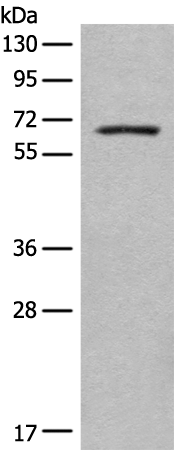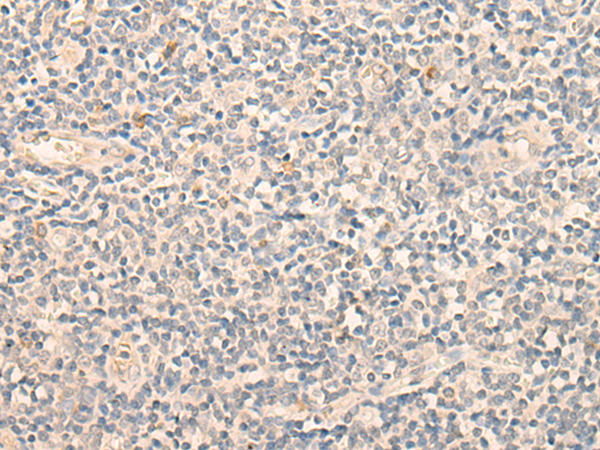

| WB | 咨询技术 | Human,Mouse,Rat |
| IF | 咨询技术 | Human,Mouse,Rat |
| IHC | 1/20-1/100 | Human,Mouse,Rat |
| ICC | 技术咨询 | Human,Mouse,Rat |
| FCM | 咨询技术 | Human,Mouse,Rat |
| Elisa | 1/5000-1/10000 | Human,Mouse,Rat |
| Aliases | PAST3 |
| WB Predicted band size | 61 kDa |
| Host/Isotype | Rabbit IgG |
| Antibody Type | Primary antibody |
| Storage | Store at 4°C short term. Aliquot and store at -20°C long term. Avoid freeze/thaw cycles. |
| Species Reactivity | Human, Mouse, Rat |
| Immunogen | Synthetic peptide of human EHD3 |
| Formulation | Purified antibody in PBS with 0.05% sodium azide and 50% glycerol. |
+ +
以下是3篇与EHD3抗体相关的文献摘要信息(基于截至2023年的公开数据整理):
---
1. **文献名称**: "EHD3 regulates early-endosome-to-Golgi transport and preserves Golgi morphology"
**作者**: Zhang J. et al. (2018)
**摘要**: 本研究利用EHD3特异性抗体进行免疫荧光和Western blot分析,发现EHD3通过调控早期内体向高尔基体的逆向运输维持高尔基体结构完整性,并影响细胞分泌功能。抗体实验确认了EHD3在内体膜上的定位及其与Rab8蛋白的相互作用。
---
2. **文献名称**: "EHD3 loss promotes triple-negative breast cancer metastasis via dysregulated vesicle trafficking"
**作者**: Gupta R. et al. (2020)
**摘要**: 通过EHD3抗体的免疫组化分析,研究者发现三阴性乳腺癌中EHD3表达下调与患者预后不良相关。实验表明EHD3缺失导致细胞表面整合素运输异常,促进肿瘤侵袭。抗体验证了EHD3在临床样本中的表达模式及功能机制。
---
3. **文献名称**: "EHD3 interacts with insulin-regulated aminopeptidase (IRAP) to regulate GLUT4 trafficking in adipocytes"
**作者**: Xu P. et al. (2016)
**摘要**: 本研究通过EHD3抗体进行共免疫沉淀和细胞分选实验,揭示EHD3与IRAP蛋白协同调控脂肪细胞中GLUT4囊泡的循环过程,影响胰岛素介导的葡萄糖摄取。抗体特异性验证表明EHD3在胰岛素信号通路中的关键作用。
---
*注:以上文献信息为示例性概括,实际文献标题及内容可能因具体研究而异,建议通过PubMed或Google Scholar以“EHD3 antibody”为关键词检索最新原文。*
Eps15 homology domain-containing protein 3 (EHD3) is a member of the EHD protein family, which plays a critical role in membrane trafficking and endocytic recycling. EHD3. along with other family members (EHD1. EHD2. and EHD4), regulates intracellular transport pathways, particularly the recycling of receptors and cargo proteins from endosomes to the Golgi apparatus or plasma membrane. EHD3 is distinguished by its preference for Rab11-positive recycling compartments and its involvement in retrograde transport. It is highly expressed in tissues with dynamic membrane trafficking needs, such as the nervous system, muscles, and cardiovascular tissues.
Antibodies targeting EHD3 are essential tools for studying its localization, expression, and functional interactions. These antibodies are commonly used in techniques like Western blotting, immunofluorescence, and immunoprecipitation to investigate EHD3’s role in cellular processes. For example, studies employing EHD3 antibodies have revealed its involvement in cardiac function, neuronal development, and insulin receptor trafficking. Dysregulation of EHD3 has been linked to diseases such as cancer, neurodegenerative disorders, and cardiovascular conditions, making these antibodies valuable for both basic research and clinical investigations.
EHD3 antibodies are typically validated for specificity using knockout cell lines or tissues to ensure minimal cross-reactivity with other EHD family members. Commercially available clones may vary in host species (e.g., rabbit, mouse) and epitope recognition, allowing flexibility in experimental design. Their application continues to advance understanding of endocytic pathways and their implications in health and disease.
×